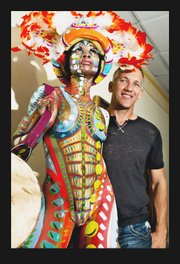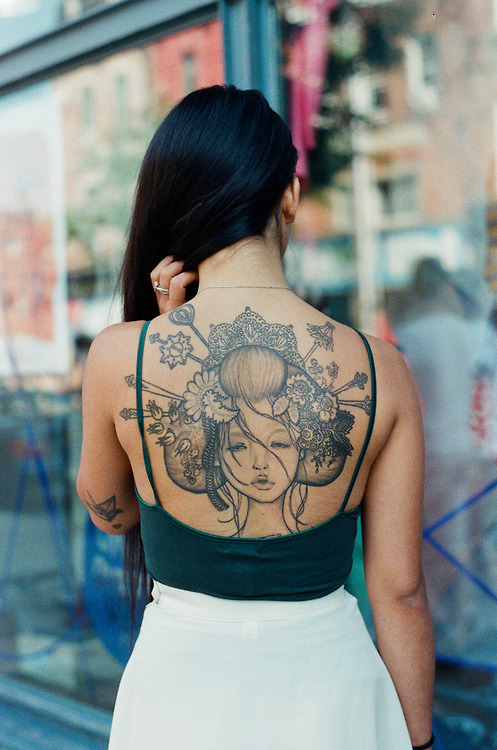Female Body Art Biography
My artwork focuses on the female body, and is to a large extent autobiographical. Issues such as beauty ideals and the body’s relationship with popular culture, fashion, health and food are central to my themes. A semiotic approach is applied to my portrayal of the body with the idea of the body being able to produce meaning and relay messages in its own right. In my work, a system of signs is dealt with in terms of the encoded aspect. In a similar way that a real live body omits signs in the form of communicative acts, which are then interpreted by perceivers, the body in the two dimensional form of images, becomes encoded with information in the form of text, icons and numbers, which is intended to be perceived in the same way; as messages to be decoded in the ornate system of signs involved with the female body and issues such as anorexia. The encoding is literally ‘written on the body’, and actually makes up the surface tonality of the body image, likening the body to a text that should be read.
The works take the form of pixilated digital inkjet prints, which are adhered to a layer of soft foam, and then built-up, pixel by pixel onto a firm surface. Each 20 x 20mm pixel contains a piece of information in the form of iconography drawn from the food, fashion, consumerism and health and fitness industries, encoding the entire image in a specific context. The finished works depict a slightly reflective, rippled and soft surface. An intimate and close-up take of different parts of the body are usually seen from the author’s perspective, rendering the camera an extension of the artist’s own eye. As a result of this, the works often take on odd compositions and slightly distorted and abstract elements. The colour of the work has been reduced to subtle flesh tones rather than full colour, as a means to enhance the private and intimate nature of the works.
The pixel plays an important role in the work, pointing to a number of elements that should be noted. The first of which is the idea of scale. Enlarging a specific area for the purpose of immense scrutiny is crucial to the work and since the images are large and pixilated, the viewer is forced to stand at a distance in order to make them visually resolve. While the image resolves at a distance, the information contained within each individual pixel cannot be seen, and requires the viewer to come forward to within a few centimeters of the work. Tension is created here through this constant pull between intimacy and distance. Repetition in the work also points to the use of the pixel. The colours of the pixels making up a digital image are often repeated, or vary slightly from one to the next, and in keeping with this notion, the information contained within the pixels in these works operates similarly. It becomes apparent that the contents of these pixels are variations of the same thing, if not repeated exactly. This repetition points to the notion of excess. Control is also an important element to the work (in relation to the body) and is enhanced by the presence of the pixel. Looking closely at a section of a pixilated image brings to mind the idea of a grid. Since the work involves a very neat, ordered and controlled method of arrangement, the use of grids is necessary throughout the process. The main purpose of these grids is to contain something or to keep something in place. These grids, in the context of the work and made evident through their pixilated nature, may be seen as a metaphor for control and conformity. Not only is the pixel a perfect square, an essentially geometric form, making up a curved, organic body, but also the format of the works themselves is a square inside which the body is contained. Almost all negative space is eliminated to highlight this notion of containment.
My artwork focuses on the female body, and is to a large extent autobiographical. Issues such as beauty ideals and the body’s relationship with popular culture, fashion, health and food are central to my themes. A semiotic approach is applied to my portrayal of the body with the idea of the body being able to produce meaning and relay messages in its own right. In my work, a system of signs is dealt with in terms of the encoded aspect. In a similar way that a real live body omits signs in the form of communicative acts, which are then interpreted by perceivers, the body in the two dimensional form of images, becomes encoded with information in the form of text, icons and numbers, which is intended to be perceived in the same way; as messages to be decoded in the ornate system of signs involved with the female body and issues such as anorexia. The encoding is literally ‘written on the body’, and actually makes up the surface tonality of the body image, likening the body to a text that should be read.
The works take the form of pixilated digital inkjet prints, which are adhered to a layer of soft foam, and then built-up, pixel by pixel onto a firm surface. Each 20 x 20mm pixel contains a piece of information in the form of iconography drawn from the food, fashion, consumerism and health and fitness industries, encoding the entire image in a specific context. The finished works depict a slightly reflective, rippled and soft surface. An intimate and close-up take of different parts of the body are usually seen from the author’s perspective, rendering the camera an extension of the artist’s own eye. As a result of this, the works often take on odd compositions and slightly distorted and abstract elements. The colour of the work has been reduced to subtle flesh tones rather than full colour, as a means to enhance the private and intimate nature of the works.
The pixel plays an important role in the work, pointing to a number of elements that should be noted. The first of which is the idea of scale. Enlarging a specific area for the purpose of immense scrutiny is crucial to the work and since the images are large and pixilated, the viewer is forced to stand at a distance in order to make them visually resolve. While the image resolves at a distance, the information contained within each individual pixel cannot be seen, and requires the viewer to come forward to within a few centimeters of the work. Tension is created here through this constant pull between intimacy and distance. Repetition in the work also points to the use of the pixel. The colours of the pixels making up a digital image are often repeated, or vary slightly from one to the next, and in keeping with this notion, the information contained within the pixels in these works operates similarly. It becomes apparent that the contents of these pixels are variations of the same thing, if not repeated exactly. This repetition points to the notion of excess. Control is also an important element to the work (in relation to the body) and is enhanced by the presence of the pixel. Looking closely at a section of a pixilated image brings to mind the idea of a grid. Since the work involves a very neat, ordered and controlled method of arrangement, the use of grids is necessary throughout the process. The main purpose of these grids is to contain something or to keep something in place. These grids, in the context of the work and made evident through their pixilated nature, may be seen as a metaphor for control and conformity. Not only is the pixel a perfect square, an essentially geometric form, making up a curved, organic body, but also the format of the works themselves is a square inside which the body is contained. Almost all negative space is eliminated to highlight this notion of containment.
Female Body Art
Female Body Art
Female Body Art
Female Body Art
Female Body Art
Female Body Art
Female Body Art
Female Body Art
Female Body Art
Female Body Art
Female Body Art
Female Body Art












No comments:
Post a Comment